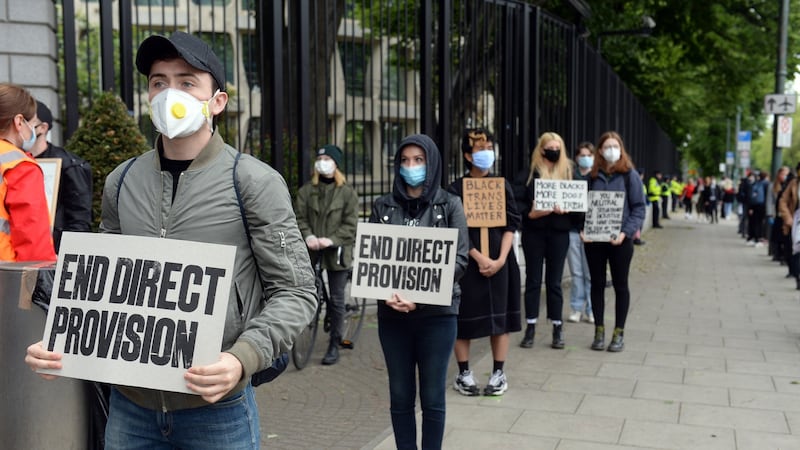Space is often carved out in the aftermath of an unexpected explosion. Sadly, tipping points of social change tend to be instigated by tragedy, and the accumulation of tragedies before them, until a certain atmosphere coalesces. What we saw in Ireland last week was a tipping point, a profound shift – generational, social, cultural – that culminated in perhaps the largest ever moment of solidarity against racial injustice here. As well as smaller protests around the country, two large demonstrations in Dublin on Monday and Saturday have changed the game. The bravery and leadership of young people of colour in Ireland has brought our country’s issues of racial injustice to the fore.
In the aftermath of the Black Lives Matter protest in Dublin on Monday, there was a discussion about public health. This was indeed an extraordinary situation. In the middle of a pandemic, people had gathered to protest in large numbers, something that is technically against regulations.
Across social media, and on Instagram in particular, young black people and people of colour detailed their experiences of racism in Ireland
But nobody expected to be attending an event of that size. The general assumption was that a few hundred people would turn up at the Spire on O’Connell Street and have ample room to physically distance and march. It just shows the depth of the feeling about racism in Ireland, the urgent need to have this conversation, the momentum behind the growing movement to end direct provision, the sense of solidarity many white people in Ireland have, and of course the extraordinary nature of the uprisings in the US and how they have inspired action and turning points in discourse in many countries around the world
These protests were preceded by the most powerful weapon in anyone’s arsenal: truth-telling. Across social media, and on Instagram in particular, young black people and people of colour detailed their experiences of racism in Ireland and their perspectives on a society that often is so keen to ignore racism that it collectively engages in magical thinking and cognitive dissonance. This happens to such an extent that many white people in Ireland turn around and say, genuinely, they are “shocked” that racism in Ireland is common, when it is endemic.
Incredibly irritating
Too often, when discussing racism even in a well-meaning way, white people look to people of colour for instruction, help, affirmation and assistance in tackling what is a white problem. This must be incredibly irritating. Nevertheless, young people of colour in Ireland have made themselves vulnerable, and have had the grace, patience, courage and dignity to share their stories. The conversations we have with each other, and the respectful listening that hopefully colours those conversations, have changed things profoundly in this country over the past decade.
This was not just a clarion call of solidarity across the Atlantic, but a mirror held up to ourselves
The energy at the protest on Monday was electric. The protest on Saturday was equally significant, if more sombre. These were also the first large mobilisations of young people on the streets in Ireland in the coronavirus era. If, in the middle of a pandemic, thousands of people are willing to protest about racism, one can only imagine the level of grassroots activism, protest and youth mobilisation we are going to see on our streets in the coming months and years. This is a generation of young people who understand deeply the power they have, who have been politicised through grassroots activism, who intuitively embody active citizenship, for whom protest is a natural activity, and who have emerged from a social revolution – clearly ongoing – rooted in empathy, solidarity, respect, creativity, optimism and hope.
People are joining the dots. This was not just a clarion call of solidarity across the Atlantic, but a mirror held up to ourselves. One of the racist structures in Ireland that has been singled out is the cruel and inhumane system of direct provision. In the Irish social revolution, a generation refuses to foster shadows and instead aims light towards the darkest, grimmest corners of our society. This is a generation that is desperate not to live with the burden of shame those older than them have stewed in. There will be no wilful ignorance or guilty reflection on the past. The need to end direct provision is being called out in real time.

White media
For the most part, there is the obvious embarrassment that Irish media had to call on people outside of its organisations to tell the story of what was happening. Irish media is profoundly white. It’s an industry that struggles immensely with the very fundamentals of diversity and inclusion. Its identity in terms of who holds power remains largely white, male, conservative and middle-class. Even basic conversations about gender representation often get shut down or are challenged and resisted. Misogyny is rife and systemic. I wonder how mainstream Irish media will even begin to self-examine about race, when as an industry it has a major issue with self-critique, and remains defensive and slow-moving when blatant inadequacies in terms of representation are called out.
For now many young people of colour in Ireland will not wait for old structures to become porous enough to let them in. They are not just banging on those doors but are forging new pathways, finding new platforms and formulating a new roadmap for us all to traverse together. Who knew such a dark time would manifest such a beacon?















